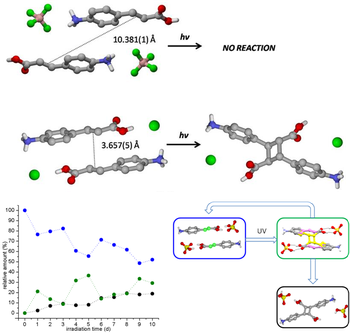
In the last decades [2 + 2] and [4 + 4] cycloaddition photoreactions in the solid state have been attracting the attention of many researchers. As a rule-of-thumb, when the molecular arrangement found in the crystal packing satisfies the Schmidt's criterion - i.e. double bonds are parallel and at a separation of less than 4.2 Å - efficient and selective reactivity is observed in most cases. Beyond purely theoretical reasons, there is also considerable interest in utilitarian applications of such transformations, e.g. for the production of polymers synthesized from natural molecules, UV-filters in plastic materials, sunscreens, and more recently also photochemical actuators displaying mechanical motion as a response to light absorption. Such reactions can be monitored by means of polarized light microscopy, infrared spectroscopy, powder and single crystal X-ray diffraction.
Prof. Fabrizia Grepioni, Prof. Dario Braga, Dr. Simone d'Agostino.